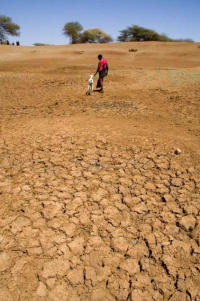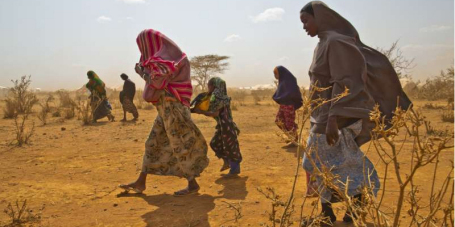Migration for Climate Adaptation
To prevent conflicts related to climate change and migration, it is important to go beyond the threat-victim dichotomy and see communities and migrants as active social agents who shape and transform their livelihoods under changing environmental conditions to find collective responses. A constructive approach would strengthen positive linkages between human migration, climate adaptation and development. Migration is considered as a complex multi-causal process that precludes isolating environmental factors from other migration drivers. This view emphasises both the challenges and the opportunities of migration for development and climate adaptation and aims to improve the understanding under which conditions “distress migration” can turn into “migration as opportunity.”
Framework of migration for adaptation

© UNHCR/B. Bannon
The impact of global warming on human communities depends on their vulnerability, which is a function of exposure and sensitivity to climate change, and adaptive capacities. Adaptation is meant here as the “adjustment in natural or human systems in response to actual or expected climatic stimuli or their effects, which moderates harm or exploits beneficial opportunities” (IPCC 2007: 869). Focusing on beneficial opportunities offers the chance to develop innovative strategies that strengthen the adaptive capacities and livelihoods of communities. This would involve not only technical innovations that facilitate sustainable management of natural resources, but also institutional innovations that shape, organise and coordinate individual and community actions and interactions (Agrawal 2008; Adger et al. 2009; Mearns & Norton 2009).
Related is the concept of social resilience, which is “the ability of communities to absorb external changes and stresses while maintaining the sustainability of their livelihoods” (Adger et al. 2002: 358). Resilient communities are active agents that influence their environment, anticipate and resist to future stresses and recreate themselves according to their motivations and capabilities. Combining absorption, resistance and recreation in social resilience transcends the reactive nature of adaptation towards anticipatory learning (Tschakert & Dietrich 2010).
These concepts are relevant to expand the multi-faceted relationship between migration and climate adaptation which has predominantly been investigated in the framework of preventing or coping with climate risks. While common strategies use adaptation to prevent forced migration, increasingly migration is considered as a legitimate adaptation strategy of communities that cannot cope with climate change (Black et al. 2011). In addition to these approaches we investigate the potential of migration for adaptation where migrant social networks can help to build social capital to increase the social resilience in the communities of origin and trigger innovations across regions by the transfer of knowledge, technology, remittances and other resources (Scheffran et al. 2012). These could increase the flexibility, diversity and creativity of communities in addressing climate stress and open new pathways for action that diversify livelihood of households, support climate adaptation and build social resilience in the regions of origin.
Capabilities and transfers of resources in migrant networks, including knowledge, remittances and return migration, can contribute to technical and institutional innovations in the home communities for climate adaptation, sustainable development and peace-building. Remittance income has direct effects on the resource base, economic well-being and resilience of the home community (Adger et al. 2002). In many countries young, professionally-trained returnees are involved in successful environmental initiatives. They understand the local socio-ecological conditions at home and are in a good position to support their communities. Technology use and transfer supports better resource efficiency, new types of natural resources and crop varieties, sustainable energy supply and disaster management. This approach contributes to improving resilience against climate change as well as rebuilding and redeveloping regions in post-conflict situations, thus avoiding negative linkages between climate change and conflict and providing positive synergies in both problem areas (Gioli et al. 2013).
Migration for adaptation is shaped by various conditions (Scheffran et al. 2012).
- Community income and migrant remittances: Being an important income source in developing countries, migrant remittances have substantially increased (World Bank 2011, 2015). Investing remittances offers opportunities for development and environment if used to preserve natural capital or protect against climate-induced risks. However, remittances could exacerbate income inequality and support passive, non-productive communities using this income source for consumption rather than investment (de Haas 2006; Adger et al. 2002) which is not necessarily negative due to multiplier effects.
- Capability, livelihood and development: Migrants acquire resources that support human capabilities which are essential for development and sustainable livelihoods (Sen 1985; Valdes-Rodriguez & Perez-Vazquez 2011). The new economics of labour migration (Taylor 1999) argues that migration has considerable innovative potential through “North–South” transfer of capital and exposes traditional communities to modern knowledge and education (de Haas 2006: 567). There are however concerns that celebrating migration as self-help development from below could “shift the attention away from structural constraints and the vital role of states in shaping favorable conditions for positive development impacts of migration” (de Haas 2010: 227).
- Diversity, resilience and social capital in migrant networks: Facing hardships, affected communities diversify their livelihoods to pursue alternative action pathways, such as agricultural intensification and non-farming activities (McDowell & de Haan 1997). Social linkages and networks are vital parts of social capital. They “tie the migrant to the source community” (Conway & Cohen 1998: 33) and empower local communities to strengthen their resilience. Return migrants can revive existing social networks to home regions and reverse the brain drain by direct transfers of knowledge and experience. Networks established through migration provide access to resources that enrich the human, social and cultural capital of home communities (Woodruff & Zenteno 2007).
- Institutions, cooperation and co-development: Governance and institutional mechanisms help to overcome barriers and enable innovative solutions in the migration process, such as self-help, social rules, and joint and sustainable management. These serve as a basis for cooperation between governments, citizen groups and businesses. To maintain resilience individuals need to merge their social capital by co-development which is a bottom-up and participatory approach initiated by immigrant organisations (Østergaard-Nielsen 2010). Co-development and related institutional processes channel diaspora contributions in knowledge transfer, remittances and return migration into measures that strengthen communities’ resilience in the home countries. These projects are financed by the migrants, or co-financed by governmental and non-governmental institutions and private entities in countries of origin and destination. In the past, the concept of co-development was problematic when Western countries applied it to instrumentalise the diaspora and regulate migration, by linking the project funding with returnee programmes and readmission agreements of “irregular” immigrants (Panizzon 2008). Sensible immigration policies could promote the exchange in resources between origin and destination areas, seeking to enhance the mutual benefits of building social capital, livelihood and resilience between migrants and their origin communities.
Conclusions
Migration is an adaptation measure that reduces pressure in climate hot spots and offers potential opportunities and resources for regions affected by climate change which can strengthen the social capital, livelihood and resilience of their communities of origin and develop innovative approaches for climate adaptation. Projects initiated and run by migrant organisations can be successful if jointly supported by institutional frameworks and co-development, involving governmental and non-governmental organisations and companies in countries of origin and destination. The United Nations can play an important role in supporting such an institutionalisation process. The 2010 Cancun Accord has provided a first step towards addressing climate change-induced migration as a policy issue on the international agenda. Within this new framework, the foundations have been laid for accepting migration as a legitimate adaptation option which, when taken seriously, would also require financial and institutional mechanisms to facilitate the migration-as-adaptation pathway. With growing relevance of climate change, the migration-for-adaptation path may gain importance beyond traditional patterns of mobility, in particular in the Sahel where the pressure to migrate increased since the 1970s possibly as a response to the onset of the persistent droughts. For those who take this step the international community needs to take supportive measures that treat migrants as active agents who develop their livelihood options.
Prof. Dr. Jürgen Scheffran
Research Group Climate Change and Security
Universität Hamburg
Dr. Elina Marmer
Insitute for Intercultural Comparative Education
University of Hamburg
Dr. Papa Sow
Center for Development Research
University of Bonn
- Adger, W. N., Kelly, P. M., Winkels, A., Huy, L. Q. & Locke, C. (2002) Migration, Remittances, Livelihood Trajectories, and Social Resilience. Journal of the Human Environment. 31 (4), p. 358-366.
- Adger, W. N., Lorenzoni, I. & O’Brien, K. (ed.) (2009) Adapting to Climate Change: Thresholds, Values, Governance. Cambridge, Cambridge University Press.
- African Development Bank (ADB) (2007) Migrant Remittances: A Development Challenge. African Development Bank.
- Agrawal, A. (2008). The role of local institutions in adaptation to climate change. Paper prepared for Social Dimensions of Climate Change meeting, Social Development Department, World Bank, Washington, March 5-6, 2008.
- Black, R., Bennett, S. R. G., Thomas, S. M. & Beddington, J.R. (2011) Migration as adaptation. Nature. 478, p. 447-449.
- Bollard, A., McKenzieb, D. & Mortenc, M. (2010) The Remitting Patterns of African Migrants in the OECD. Journal of African Economies. 19 (5), p. 605–634.
- Conway, D. & Cohen, J. (1998) Consequences of migration and remittances for Mexican transnational communities. Economic Geography. 74, p. 26-44.
- de Haas, H. (2006). Migration, remittances and regional development in Southern Morocco, Geoforum 37 (2006), 565–580.
- de Haas, H. (2010). Migration and Development: A Theoretical Perspective. International Migration
- Gioli, G., Khan, T. & Scheffran, J. (2013): Remittances and community resilience to conflict and environmental hazards in Northwestern Pakistan. Remittances flows to post-conflict states: Perspective on human security and Development Boston: Pardee Center p. 117-127.
- Gonin, P. (2001). Les migrations venant du basin du fleuve Senegal vers l’Union Europèenne. Lecture for the symposium “L’etat des migrations vers l’Europe. Facteurs d’emigration, politiques d’immigration”. Brussels, 21.03.2001
- IPCC (2007). Climate Change 2007. Climate Change Impacts, Adaptation and Vulnerability (Geneva: Intergovernmental Panel on Climate Change).
- McDowell, C. & de Haan, A. (1997) Migration and Sustainable Livelihoods: A Critical Review of the Literature. IDS Working Paper 65. Sussex, IDS.
- Mearns, R. & Norton, A. (ed.) (2009) Social Dimensions of Climate Change: Equity and Vulnerability in a Warming World. Washington, D.C., World Bank.
- Østergaard-Nielsen, E. (2010). Codevelopment and citizenship: the nexus between policies on local migrant incorporation and migrant transnational practices in Spain. Ethnic and Racial Studies, 1466-4356, 34 (1), 20-39
- Page, J. & Plaza, S. (2005) Migration Remittances and Development: A Review of Global Evidence. Journal of African Economies. 15 (2), p. 245-336.
- Panizzon, M. (2008). Labour mobility: A win-win-win model for trade and development. The case of Senegal. Geneva Trade and Development Forum, 24–25 April, 2008
- Sall, B. (2005). Remittances and Economic Initiatives in Sub-Saharan Africa. In: Migration, Remittances and Development. OECD. Paris.
- Scheffran, J., Marmer, E. & Sow, P. (2012) Migration as a contribution to resilience and innovation in climate adaptation: Social networks and co-development in Northwest Africa. Applied Geography. 33, p. 119-127.
- Sen, A. (1985). Commodities and Capabilities, Amsterdam: North-Holland.
- Sow, P. & Alissoutin, R. L. (2010) ICT and codevelopment in Senegal and Catalonia. Mireia Fernandez-Ardevol & Ros Adela (ed.), p. 319-342. Spain, IN3 Catalonia.
- Sow, P., Adaawen, S.A. & Scheffran, J. (2014) Migration, Social Demands and Environmental Change amongst the Frafra of Northern Ghana and the Biali in Northern Benin. Sustainability. 6 (1), p. 375-398.
- Taylor, J.E. (1999). The new economics of labour migration and the role of remittances in the migration process. Internatioanal Migration, 37, 63–88.
- Tschakert, P. & Dietrich, K.A. (2010) Anticipatory Learning for Climate Change Adaptation and Resilience. Ecology and Society. 15 (2), p. 11.
- Valdes-Rodriguez, O. A. & Perez-Vazquez, A. (2011) Sustainable livelihoods: an analysis of the methodology. Tropical and Subtropical Agroecosystems. 14 (1), p. 91-99.
- Woodruff, C. & Zenteno, R. (2007) Migration networks and microenterprises in Mexico. Journal of Development Economics. 82 (2), p. 509-528.
- World Bank (2011). Migration and Remittances Factbook. Second Edition.
- World Bank (2015) Migration and Remittances: Recent Developments and Outlook. Migration and Development Brief 24 April 2013.

